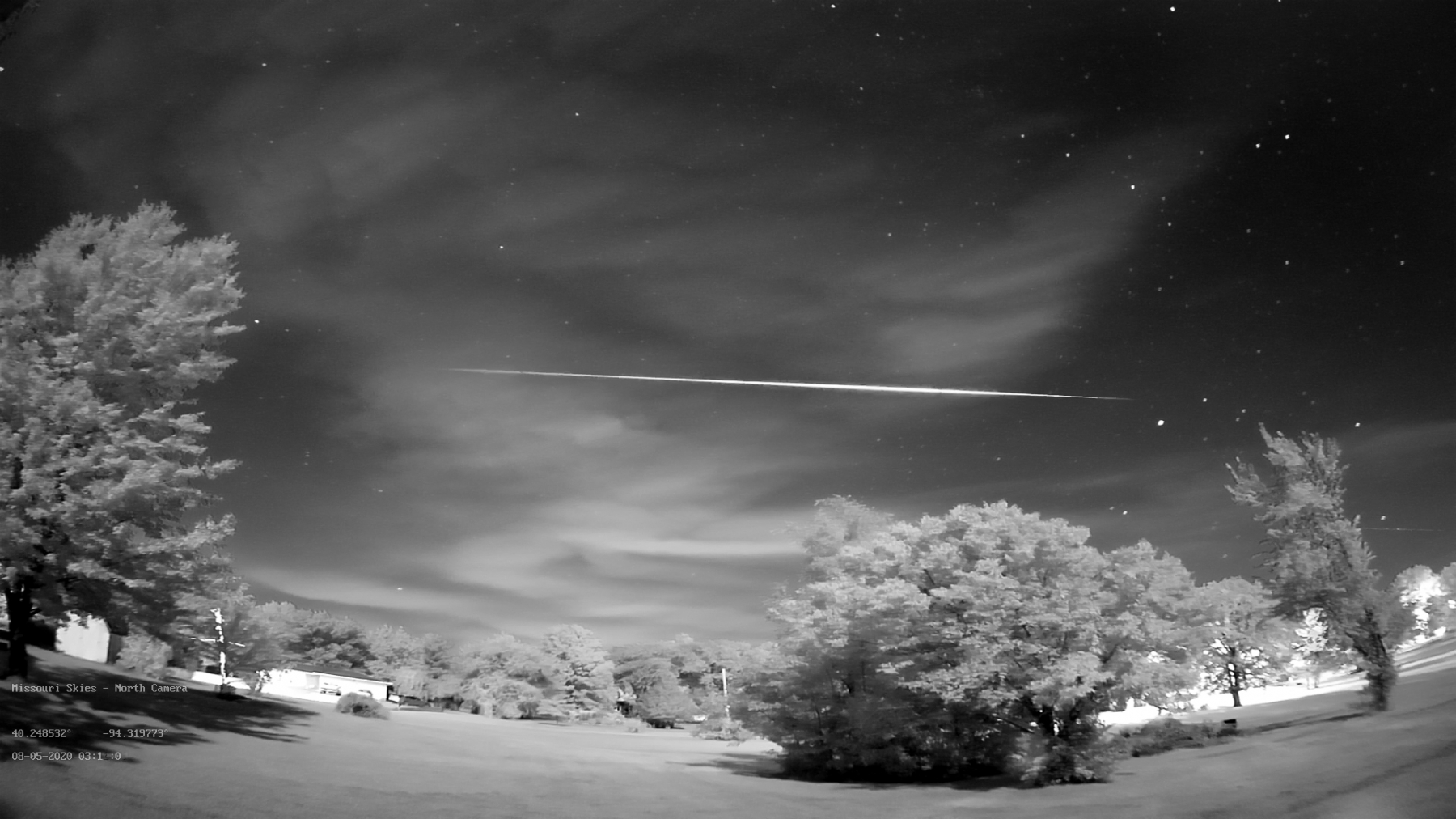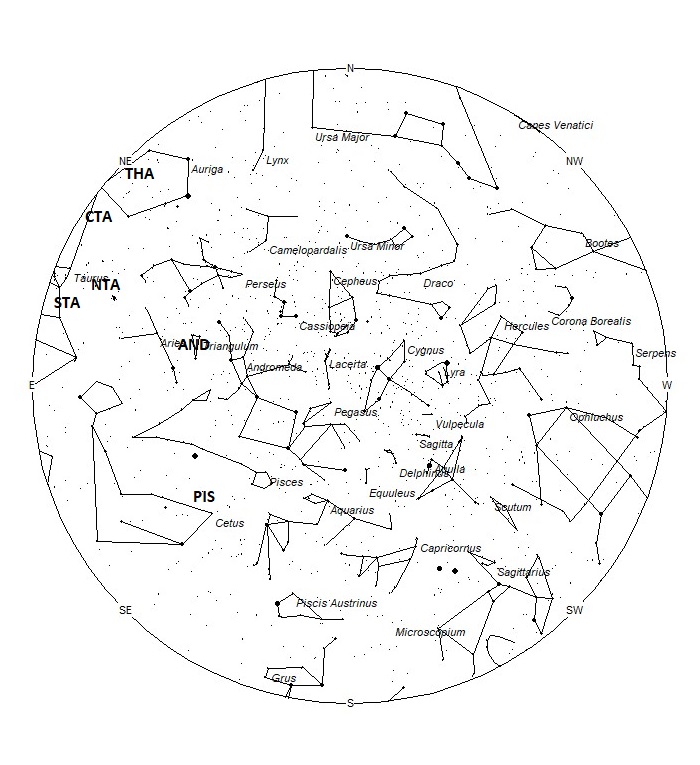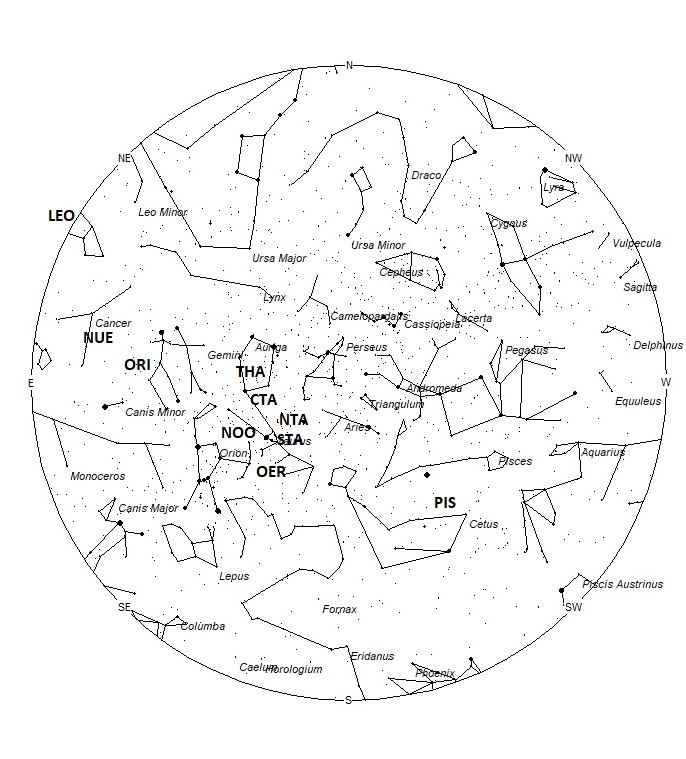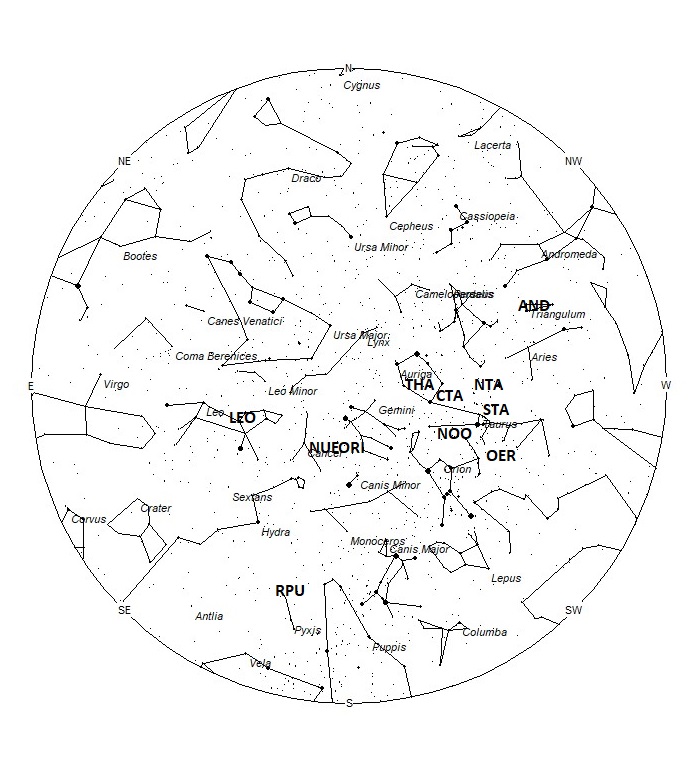 Daniel Bush’s camera caught this fireball at 03:11 CDT (08:11 UT) on the morning of August 5, 2020, from Albany, Missouri, USA. Credit Daniel Bush.
Daniel Bush’s camera caught this fireball at 03:11 CDT (08:11 UT) on the morning of August 5, 2020, from Albany, Missouri, USA. Credit Daniel Bush.During this period, the moon reaches its new phase on Sunday November 15th. At this time, the moon is located near the sun and is invisible at night. As this period progresses, the waxing crescent moon will enter the evening sky but will not interfere with meteor observations, especially during the more active morning hours. The estimated total hourly meteor rates for evening observers this week is near 4 as seen from mid-northern latitudes and 3 as seen from tropical southern locations (25S). For morning observers, the estimated total hourly rates should be near 20 as seen from mid-northern latitudes (45N) and 14 as seen from tropical southern locations (25S). The actual rates will also depend on factors such as personal light and motion perception, local weather conditions, alertness, and experience in watching meteor activity. Note that the hourly rates listed below are estimates as viewed from dark sky sites away from urban light sources. Observers viewing from urban areas will see less activity as only the brighter meteors will be visible from such locations.
The radiant (the area of the sky where meteors appear to shoot from) positions and rates listed below are exact for Saturday night/Sunday morning November 14/15. These positions do not change greatly day to day so the listed coordinates may be used during this entire period. Most star atlases (available at science stores and planetariums) will provide maps with grid lines of the celestial coordinates so that you may find out exactly where these positions are located in the sky. A planisphere or computer planetarium program is also useful in showing the sky at any time of night on any date of the year. Activity from each radiant is best seen when it is positioned highest in the sky, either due north or south along the meridian, depending on your latitude. It must be remembered that meteor activity is rarely seen at the radiant position. Rather they shoot outwards from the radiant, so it is best to center your field of view so that the radiant lies at the edge and not the center. Viewing there will allow you to easily trace the path of each meteor back to the radiant (if it is a shower member) or in another direction if it is sporadic. Meteor activity is not seen from radiants that are located far below the horizon. The positions below are listed in a west to east manner in order of right ascension (celestial longitude). The positions listed first are located further west therefore are accessible earlier in the night while those listed further down the list rise later in the night.
These sources of meteoric activity are expected to be active this week.
.
During the week centered on November 13th, there is the possibility of activity from a source known as the 29 Piscids (PIS). These meteors would radiate from an area located near 00:27 (007) -07. This area of the sky is located on the Pisces/Cetus border, 3 degrees northeast of the 4th magnitude star known as Deneb Kaitos Shemali (iota Ceti). This area of the sky is best placed during the evening hours near 21:00 local standard time (LST). With an entry velocity of 11 km/sec., any meteors from this source would be very slow. It’s not certain whether a repeat of the 2019 activity will occur, but if any meteors from this source are observed, it would be notable.
The Andromedids (AND) should be active from a radiant currently is located near 02:03 (031) +32. This position lies in central Triangulum, 3 degrees northeast of the 3rd magnitude star known as Mothallah (alpha Trianguli). This part of the sky is best placed near 2300 LST, when the radiant lies highest above the horizon. Current rates would most likely be less than 1 per hour no matter your location. With an entry velocity of 19 km/sec., the average Andromedid meteor would be of very slow velocity.
The Southern Taurids (STA) are active from a large radiant centered at 03:56 (059) +15. This area of the sky is located in western Taurus, 3 degrees northwest of the 3rd magnitude variable star known as lambda Tauri. This source is best placed near midnight LST when it is located highest in the sky. Current hourly rates would be near 2 no matter your location. With an entry velocity of 27 km/sec., most activity from this source would possess medium-slow velocities.
The Northern Taurids (NTA) are active from a large radiant centered at 04:03 (061) +24. This area of the sky is located in western Taurus, 3 degrees east of the naked eye open star cluster known as the Pleiades. This source is best placed near midnight LST when it is located highest in the sky. Current hourly rates would be near 3 as seen from the northern hemisphere and 2 as seen from south of the equator. With an entry velocity of 27 km/sec., most activity from this source would possess medium-slow velocities.
The omicron Eridanids (OER) were discovered by Japanese observers using video data from SonotoCo in 2007-2008. The activity period ranges from October 16–November 24 with maximum activity occurring on November 5th. The radiant is currently located at 04:04 (061) +01, which places it on the Eridanus/Taurus border, 5 degrees south of the 4th magnitude star known as nu Tauri. These meteors may be seen all night long but the radiant is best placed near midnight LST when it lies on the meridian and is located highest in the sky. Current hourly rates should be near 1 no matter your location. With an entry velocity of 29 km/sec., the average omicron Eridanid meteor would be of medium-slow velocity.
The chi Taurids (CTA) were discovered by Dr. Peter Brown during his 7-year survey using the Canadian Meteor Orbit Radar (CMOR). This source is active from October 20 through November 17 with a maximum occurring near November 4th. Current rates would be less than 1 per hour no matter your location. The radiant is currently located at 05:04 (076) +28, which places it on the Taurus/Auriga border, 4 degrees west of the 2nd magnitude star known as El Nath (beta Tauri). These meteors may be seen all night long but the radiant is best placed near 0100 LST when it lies on the meridian and is located highest in the sky. Current rates should be less than 1 per hour no matter your location. With an entry velocity of 41 km/sec., the average chi Taurid meteor would be of medium velocity.
The November Orionids (NOO) are active from a radiant located at 05:08 (077) +16. This area of the sky lies in eastern Taurus, 7 degrees east of the bright orange star known as Aldebaran (alpha Tauri). This radiant is best placed in the sky near 0300 LST, when it lies highest above the horizon. This stream is active from November 7 through December 17, with maximum activity occurring on November 29. Rates should be 1 per hour as seen from the northern hemisphere and less than 1 as seen from south of the equator. With an entry velocity of 43 km/sec., most activity from this radiant would be of medium speed.
The November theta Aurigids (THA) were discovered by Dr. Peter Brown using the Canadian Meteor Orbit Radar. This stream is active from November 17 through December 1, with maximum activity occurring on November 26. The radiant currently lies at 05:40 (085) +35, which places it in central Auriga, 4 degrees southwest of the 3rd magnitude star known as Mahasim (theta Aurigae A). This area of the sky is best placed in the sky near 0200 LST, when it lies highest above the horizon in a dark sky. Rates should be less than 1 per hour no matter your location. With an entry velocity of 33 km/sec., most activity from this radiant would be of medium-slow velocity. These meteors are expected to be faint and may be difficult to observe unless viewing conditions are near optimum. Lastly, the radiant drift for this source resembles that of the Geminids, if that source was extended back into November. Therefore, these meteors may actually be early members of the Geminid meteor shower, which is active from December 1-22.
The last of the Orionids (ORI) will be seen this week from a radiant located at 07:24 (111) +16. This area of the sky lies in southeastern Gemini, 2 degrees east of the 4th magnitude star known as lambda Geminorum. The radiant is best placed near 0400 LST, when it lies highest above the horizon. Hourly rates would less than 1 no matter your location. With an entry velocity of 66 km/sec., most activity from this radiant would be of swift velocities.
The last of the nu Eridanids (NUE) are expected this week. Activity from this long-period stream stretches from August 24 all the way to November 16. Maximum activity occurred on September 24th. The radiant currently lies at 08:28 (127) +16, which places it in southern Cancer, 4 degrees southwest of the 4th magnitude star known as Asellus Australis (delta Cancri). This area of the sky is best seen during the last dark hour before dawn when the radiant lies highest in a dark sky. Current rates are expected to be less than 1 per hour during this period no matter your location. With an entry velocity of 67 km/sec., the average meteor from this source would be of swift velocity.
The rho Puppids (RPU) were discovered by Damir Šegon and the Croatian Meteor Network team based on studying SonotaCo and CMN observations (SonotaCo 2007-2011, CMN 2007-2010). These meteors are active from November 10-20 with maximum activity occurring on the 14th. The current position of this radiant is 08:45 (131) -27. This area of the sky lies in central Pyxis, 1 degree northwest of the 4th magnitude star known as gamma Pyxidis. These meteors are best seen during the last dark hour prior to dawn when it lies highest in a dark sky. Rates are expected to be less than 1 per hour as seen from the northern hemisphere and near 1 per hour as seen from south of the equator. With an entry velocity of 58 km/sec., most activity from this radiant would be of swift velocity.
The Leonids (LEO) are expected to peak on the morning of November 17th from a radiant located at 10:15 (154) +22. This position lies in northwestern Leo, 1 degree south of the 3rd magnitude star known as Adhafera (zeta Leonis). The Leonid radiant is best placed during the last hour before morning twilight when the radiant lies highest in a dark sky. Leonids may be seen from the southern hemisphere but the viewing conditions are not quite as favorable as those north of the equator. Rates at maximum are expected to be 5-10 per hour just prior to dawn. With an entry velocity of 70 km/sec., most activity from this radiant would be of swift speed with numerous persistent trains on the brighter meteors.
As seen from mid-northern hemisphere (45N), sporadic morning rates would be near 11 per hour as seen from rural observing sites and 3 per hour during the evening hours. As seen from the tropical southern latitudes (25S), one would expect to see approximately 7 sporadic meteors per hour during the last hour before dawn as seen from rural observing sites. Evening rates would be near 2 per hour. Locations between these two extremes would see activity between the listed figures.
| SHOWER | DATE OF MAXIMUM ACTIVITY | CELESTIAL POSITION | ENTRY VELOCITY | CULMINATION | HOURLY RATE | CLASS |
| RA (RA in Deg.) DEC | Km/Sec | Local StandardTime | North-South | |||
| 29 Piscids (PIS) | Nov 13 | 00:27 (007) -07 | 11 | 21:00 | <1 – <1 | IV |
| Andromedids (AND) | Nov 06 | 02:03 (031) +32 | 19 | 22:00 | <1 – <1 | IV |
| Southern Taurids (STA) | Nov 03 | 03:56 (059) +15 | 27 | 00:00 | 2 – 2 | II |
| Northern Taurids (NTA) | Nov 12 | 04:03 (061) +24 | 27 | 00:00 | 3- 2 | II |
| omicron Eridanids (OER) | Nov 05 | 04:04 (061) +01 | 29 | 00:00 | <1 – <1 | IV |
| chi Taurids (CTA) | Nov 04 | 05:04 (076) +28 | 41 | 01:00 | <1 – <1 | IV |
| November Orionids (NOO) | Nov 29 | 05:08 (077) +16 | 43 | 01:00 | 1 – <1 | II |
| November theta Aurigids (THA) | Nov 26 | 05:40 (085) +35 | 33 | 02:00 | <1 – <1 | IV |
| Orionids (ORI) | Oct 21 | 07:24 (111) +16 | 66 | 04:00 | <1 – <1 | I |
| nu Eridanids (NUE) | Sep 24 | 08:28 (127) +16 | 67 | 05:00 | <1 – <1 | IV |
| rho Puppids (RPU) | Nov 14 | 08:45 (131) -27 | 58 | 05:00 | <1 – 1 | IV |
| Leonids (LEO) | Nov 17 | 10:15 (154) +22 | 70 | 06:00 | 3 – 2 | I |
 American Meteor Society
American Meteor Society



I heard a sound about 20 times louder than a airplane plane around 5:30 ish I’m almost positive it was a meteor in the atmosphere.
Wonderful! Thanks so much!
Just saw a fire ball in Overland Park is
Last night my son and husband heard a loud sound. We went outside and captured the most amazing video of what appeared to be possibly a spaceship. All we could see was a steady center surrounded by many objects/lights going in a circular motion in a steady pace. It was the most beautiful but at the same time terrifying experience because it definitely was not of the ordinary. It was like something out of a movie and appeared to get larger as we stood there. At one point it was shooting something that looked like the lit up objects out into the space around it creating a bigger surrounding. I still cannot believe what we saw.
On Nov 14th at 7:50 pm (Paradise, California) we saw a large orangish fireball with a tail that seemed extremely low, go northernly straight over us and continued till it disappeared over the horizon. Never have I seen such a long or large colored shooting star or meteor?